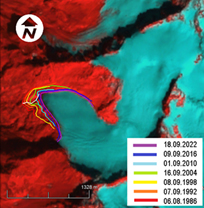The positive solution of this equation is approximately 154. This result means that if the current trend of retreat continues, the Adishi Glacier will probably melt completely in 154 years, or in 2131 (the starting point is 1977).
Also, according to ground-based data from field observations, the retreat of the Adishi Glacier from 1985 to 2022 was 614 m. The sum of these two numbers, 7435, should equal the trend equation, and then the resulting quadratic equation should be solved:




